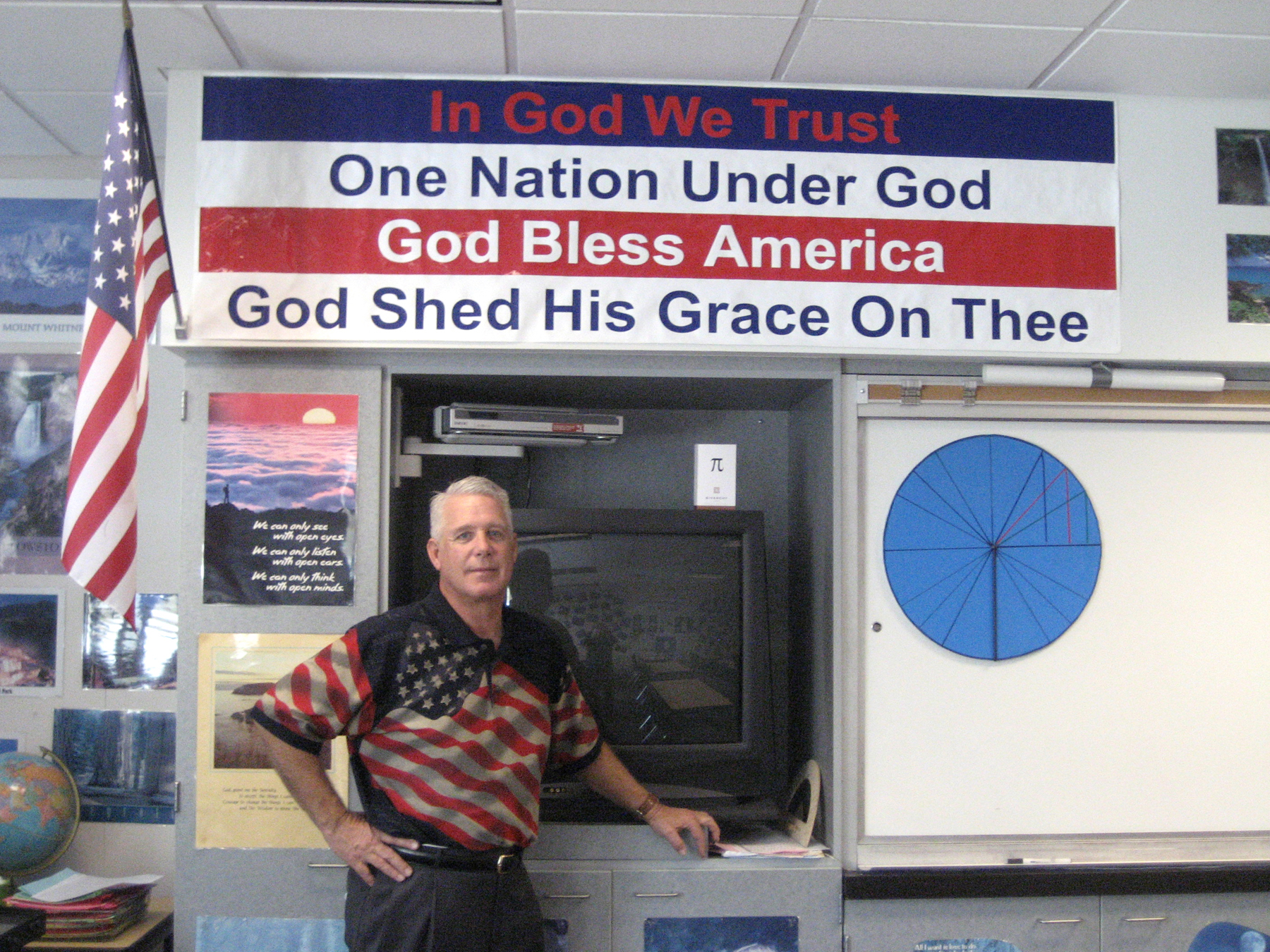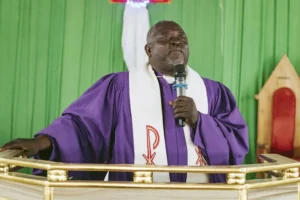
SAN DIEGO (BP)–A San Diego math teacher was forced to remove two posters from his classroom walls because they included the phrases “In God We Trust,” “One Nation Under God” and “God Bless America.”
A federal judge said the Poway Unified School District was wrong to order the removal of the posters, and now the school district is appealing the judge’s decision to the Ninth Circuit Court of Appeals.
Brad Johnson, who has been an educator for 32 years, told Baptist Press he began hanging motivational posters in his classroom early in his career.
As he stood with his students to recite the Pledge of Allegiance, and as he thought about the Declaration of Independence and other staples of American history, he decided to hang a red, white and blue poster reflecting the sentiments of the nation. The poster hung in his classroom for 25 years without anyone complaining.
About 20 years ago, Johnson added another poster that says “All Men Are Created Equal, They Are Endowed By Their Creator.”
“I have a lot of nature pictures in my classroom from national parks and other nationally recognized scenes, so I put that poster up around all my nature pictures to reflect that as a nation we believe that we’re not here as an accident, that we’ve been created and we’ve been endowed by a Creator with our rights,” Johnson, a math teacher at Westview High School, said.
Johnson doesn’t talk about the posters in class, and he said students have commented that his classroom is a relaxing, refreshing and inspirational place.
But in the fall of 2006, another math teacher asked the principal why the posters were permitted. The principal sought guidance from district administrators, and the assistant superintendent, Bill Chiment, was assigned to investigate.
Chiment reasoned, according to the court ruling, that none of the individual phrases on the posters would be a problem, but the combined influence “over-emphasized” God. He also said the phrases were taken out of their original contexts, and as a solution he proposed that Johnson place a full copy of the Declaration of Independence and pictures of U.S. coins on the wall.
Johnson asserted his right to hang the posters in his classroom, and the Thomas More Law Center, a national public interest law firm based in Michigan, filed a federal lawsuit on his behalf in 2007.
U.S. District Judge Roger Benitez ruled in February that Johnson’s First Amendment rights were violated and that he should be allowed to hang the posters. Benitez said the posters clearly constitute free speech, and public school teachers have First Amendment rights.
“That God places prominently in our Nation’s history does not create an Establishment Clause violation requiring curettage and disinfectant for Johnson’s public high school classroom walls,” Benitez wrote in his 32-page opinion. “It is a matter of historical fact that our institutions and government actors have in past and present times given place to a supreme God.”
The Supreme Court has identified, he added, an “unbroken history of official acknowledgement by all three branches of government of the role of religion in American life from at least 1789.”
“There is no realistic danger that an observer would think that the Poway Unified School District was endorsing a particular religion or a particular church or creed by permitting Johnson’s personal patriotic banners to remain on his classroom wall,” the judge wrote. “Any perceived endorsement of a single religion is dispelled by the fact that other teachers are also permitted to display other religious messages and anti-religious messages on classroom walls.”
Benitez noted that other classrooms at the school contain posters quoting John Lennon’s “Imagine” and Hindu leader Mahatma Gandhi, as well as posters of the Buddhist leader Dalai Lama and Muslim leader Malcolm X, a Libertarian Party poster, a “Stop Global Warming” sign, and an anti-war poster that says, “How many Iraqi children did we kill today?” among others.
Johnson said he was stunned when his posters were singled out for removal.
“I wondered what had changed in our culture and in the school district’s opinion of the banners that they’d all the sudden tell me to take them down,” he said, adding that he didn’t have peace about taking them down without pursuing whether it was a violation of his free speech rights.
He took the posters down in order to comply with his employers’ directive, but he put them up again the day after the judge ruled in his favor. He didn’t say anything to the students, but he did place some red, white and blue balloons throughout the classroom to celebrate.
“When the students came in and saw that they were up, they applauded, and it was very affirming that they did that. They respect my stance and I think I’m a highly respected teacher in the district. I’ve never had a complaint from any of my students who felt I was trying to proselytize or push my views. They just see me as a patriotic teacher,” Johnson said.
As the case heads to the Ninth Circuit, Johnson said he is aware that the court is known as the most liberal in the nation, and he realizes his chances for success may hinge on which three-judge panel he draws. If that court overturns the lower court’s ruling, Johnson said, he is prepared to take his case to the U.S. Supreme Court, which he believes would stand behind his right to display the posters.
“School officials have stated under oath that they have no objection to allowing teachers to promote personal political causes such as gay rights and global warming,” Robert Muise, Johnson’s attorney at the Thomas More Law Center, said.
“And they have no objection to a 40-foot display of sacred Tibetan prayer flags in a science classroom, among countless other religious and political displays. But they do have a personal objection to Mr. Johnson’s patriotic banners because they recognize a fundamental truth that school officials dislike: God plays a prominent role in our nation’s history and heritage,” Muise said.
–30–
Erin Roach is a staff writer for Baptist Press.

















